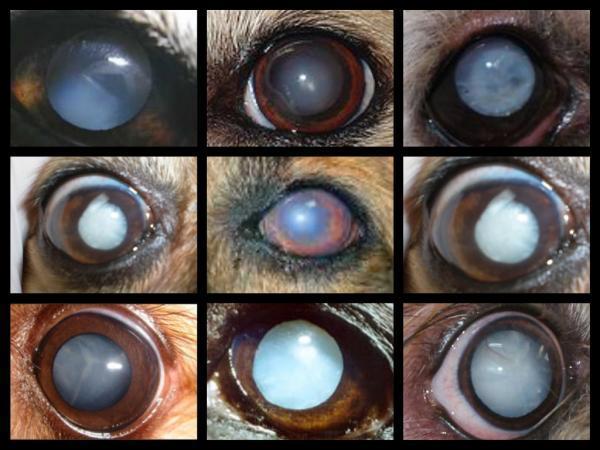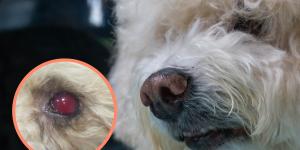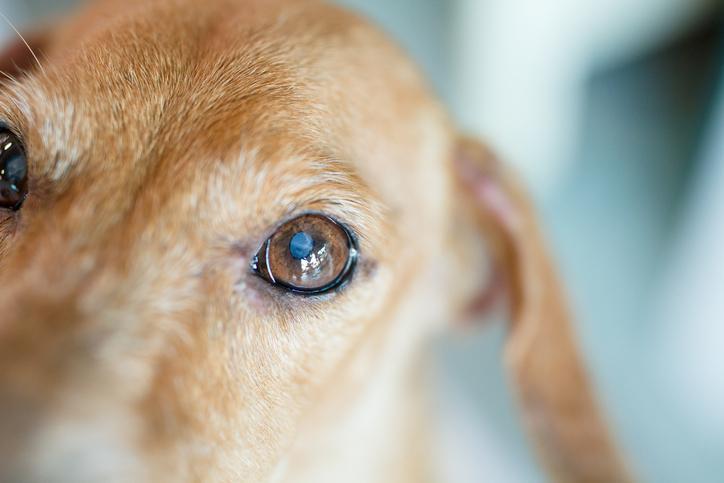My Dog's Eye Has a Blue Tint - Nuclear Sclerosis in Dogs



See files for Dogs
It's common for middle-aged to senior dogs to develop a bluish transparent haze in the lens of their eyeThis is considered a normal change in the lens associated with aging. The medical term for this occurrence is nuclear sclerosis.
In this AnimalWised article we're going to talk about nuclear sclerosis in dogs, the causes, symptoms and treatment. Continue reading to learn more!
Causes of nuclear sclerosis in dogs
Nuclear sclerosis consists of a normal and progressive degeneration of the lens that occurs as a result of the passage of time. Although the exact mechanism of how this process occurs isn't completely understood, nuclear sclerosis is associated with aging.
To put it into simple terms, the cause of this occurence is believed to be the compression by new lens fibers, produced throughout their life, that leads to the hardening and and the discoloration of their lens. This only happens to middle-aged to senior dogs. If your puppy or young dog has a blue hue in their eyes, it is not due to nuclear sclerosis.
This medical term is often associated with cataracts in elderly dogs as the symptoms overlap. Nevertheless, they are two different conditions that require different treatments. This is why it's so important to take your dog to the veterinarian when you observe an abnormal behaviour or occurence. This way, they can be properly examined, diagnosed and treated.
Learn more in our article about the most common eye problems in dogs.
Difference between cataracts and nuclear sclerosis in dogs
As these two medical terms often get confused with one another, we're going to explain the difference between nuclear sclerosis and cataracts.
As previously stated, nuclear sclerosis occurs as a degeneration of the lens, associated with aging. This occurs naturally to middle-aged and senior dogs. There is no tear or break in the lens tissue, it simply hardens and has a hue tint.
On the other hand, cataracts is defined as the opacity of the lens and occurs due to a break in the lens tissue. This can occur to dogs of all ages, not just senior dogs. Dogs with cataracts suffer from vision loss as the opaque lens doesn't permit an image to form on the retina
Nuclear sclerosis symptoms in dogs
The only symptom of nuclear sclerosis in dogs is the detection of a bluish haze over the lens. The lens separates the anterior and posterior segments of the eyeball. It is a transparent structure with the shape of a biconvex lens located behind the pupil. Its function is to focus on objects at different distances thanks to the contraction of the ciliary muscles.
Therefore, a dog with nuclear sclerosis will have a bluish haze on the lens as a consequence of the changes caused by age. It is essential to know that this degeneration does not pose any problem for vision. The dog sees as always because the change that occurs is not significant and has had time to gradually get used to it.
Therefore, in general, a haze without any other changes or symptoms in an older dog guides the diagnosis toward nuclear sclerosis. On the contrary, if the mist is accompanied by a disoriented dog, which stumbles over objects or presents any other damage to the eye, it is more likely that it suffers from some pathology and not nuclear sclerosis.
It's also important to understand that a dog can suffer from two separate health conditions. In order to properly diagnose them and know what exactly the issue is, as their caregiver, we must take them to the veterinarian to be examined, diagnosed and treated.
If your dog has more symptoms than just a bluish haze in their lens, it's probable that they are either suffering from cataracts or by nuclear sclerosis and another health condition. When it comes to senior dogs, it's recommended that they have more frequent veterinarian check ups as they become more prone to health issues.
If you're currently caring for a senior dog, you may also be interested in our article about 10 signs of old age in dogs.

Treatment of nuclear sclerosis in dogs
There is no treatment for nuclear sclerosis. This is because it is a degeneration produced by age and is, therefore, irreversible.
In any case, it doesn't need to be treated as it's not a pathology. It's simply a physiological alteration that doesn't affect our dog's vision. Beyond the change in the color of their eye, there are no repercussions other than aesthetics. This condition will not alter your dog's quality of life as it doesn't bother or hurt them in any way, nor does it cause vision loss.
So, if you've taken your dog to the veterinarian and they have determined that your dog only has nuclear sclerosis, you shouldn't worry. Continue to provide your dog with the lots of love and attention and they will be happy.
This article is purely informative. AnimalWised does not have the authority to prescribe any veterinary treatment or create a diagnosis. We invite you to take your pet to the veterinarian if they are suffering from any condition or pain.
If you want to read similar articles to My Dog's Eye Has a Blue Tint - Nuclear Sclerosis in Dogs, we recommend you visit our Eye problems category.
- Carlson and Giffin. (2002). Practical manual of canine veterinary medicine . Madrid. Editorial el Drac.
- Esteban, Javier. Ophthalmological conditions in the geriatric patient . Veterinary Center No. 53. pp. 4-14.






